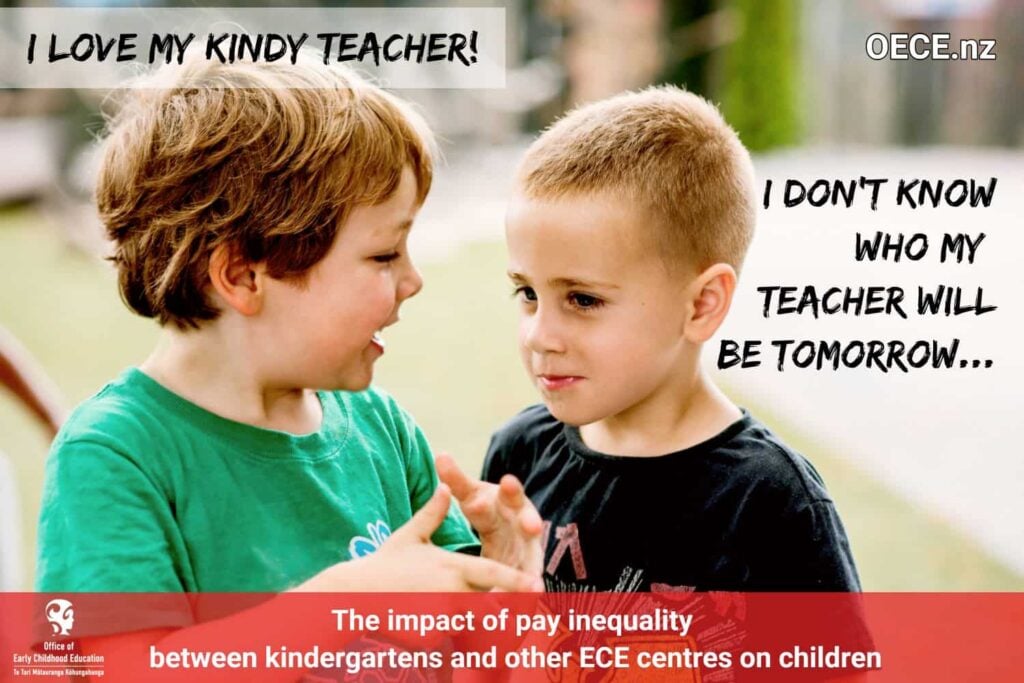This report examines early childhood education ECE Sector Workplace Bullying.
It draws on the responses of 900 teaching staff and supervisors and 80 childcare business owners/commercial operators to questions about bullying, asked as part of our 2017 ECE Quality and Employment Survey.
Bullying is recurrent, intentionally harmful acts which involve a power imbalance between the bullies (the aggressor) and the bullied (or victim). Worksafe NZ defines workplace bullying as “repeated and unreasonable behaviour directed towards a worker or group of workers.”
Two-thirds of ECE teachers (teaching staff and supervisors) surveyed reported they had not been bullied in the last 12 months – but this also means that one-third had been bullied (33%). This is an increase from three years ago when 25 percent of teachers reported being bullied in the last 12 months (2014 survey results).
Moreover, 18 percent of teachers reported that while they may not have been personally bullied they had observed someone else being bullied at work. Bosses were most often the people who did the bullying, followed by work colleagues, and parents/ caregivers.
Sixteen percent of service owners reported they had been personally bullied. The bully was most often a staff member or parent.
Bullying was more likely to be experienced by teachers (including head and senior teachers) working in kindergarten than in any other type of service (40% of kindergarten staff). However some regions were disproportionately represented in reports of bullying, suggesting that bullying is not related to the type of service but what goes on in any particular service or kindergarten association.
Private and community-based ECE services were similar in rates of reported bullying (31% and 34% respectively). However, of the teachers who reported being bullied, those working at private services were significantly more likely be bullied by their boss or leader (64%) compared with those at community-based services (52%).
Bullying in ECE Workplaces
By Rachel Pratt and Sarah Alexander.
June 4, 2018.
Introduction
The effects on children

Rates of bullying are high in NZ primary schools compared with many other countries. Bullying has negative effects on student identity, wellbeing and achievement. The Trends in International Mathematics and Science Study (TIMMS) found that Year 5 school students who reported the most frequent bullying had significantly lower achievement in mathematics and science.
Because the effects of bullying at school-age are well known, there has been a strong focus on talking about bullying in schools and implementation of anti-bullying programmes.
But according to the Growing Up in NZ longitudinal Study bullying can start well before children step into a primary school. It was found that being bullied or picked on was a constant experience for around one in ten children from the age of two years. Clearly then children are witnessing and experiencing bullying in the early childhood years.
Less is known on the bullying of teachers. These people are role models to children and they, along with the owners of services, are responsible for providing the care and learning environment in which young children spend a lot of time.
Around 96 percent of all children in NZ attend an early childhood service before they start school so it is important to give attention to bullying within this environment.
Professional and legal obligations
All ECE teachers holding a practising certificate are required by the Education Council to treat colleagues with respect and act professionally. Section 1 of Our Code, Our Standards (Code of Professional Responsibility and Standards for the Teaching Profession) describes the importance of teachers demonstrating a “high standard of professional and personal behaviour” and “engaging in professional, respectful and collaborative relationships with colleagues.”
As well as professional obligations there are legal ones too. Staff can be held liable under health and safety legislation and human rights legislation if they have bullied others in the workplace. All employers have a legal responsibility to protect staff from bullying under the Health and Safety at Work Act 2015. An employer’s failure to deal with bullying could lead to legal liability, including a personal grievance claim brought by affected staff.
However the nature of bullying can make it difficult for an employee to speak up. A personal grievance must be raised within 90 days of the date when the problem happened or it came to the employee’s attention. It may not be possible emotionally and physically for a person who has been bullied to make a claim within this short of period of time.
Why is the ECE workforce vulnerable?
Throughout the history of ECE in NZ teachers have been referred to by terms such as ‘nice ladies’ and this is a label or public perception that has not been challenged and furthermore the profession remains one that is for women and low-paid. Those working in early childhood education are known to do so because they have attributes of kindness and a willingness to put others ahead of themselves – however people who like to control and use people may also be attracted to the sector knowing this vulnerability.
Another reason for vulnerability is that there is a lack of policy on bullying in ECE. It would seem that the Ministry of Education generally regards workplace bullying in early childhood education and any complaints relating to this as private matters concerning employment. So at the top in the education system there has not been much talk and no significant action to address ECE bullying even though, as this report highlights, it results in teachers leaving their positions and/or teaching altogether, affects how well teaching teams function, and can be detrimental to the quality of the environment in which children learn and are cared for.
Recommendations on ECE Sector Workplace Bullying
The Education Council’s Code of Professional Responsibility “serves as a tool to assist initial teacher education providers to support student teachers to understand the standards of conduct and integrity expected of everyone in the profession.” However in practice, the nature of bullying is such that it can be difficult for a person who is bullied to speak up about this and to report a person who is bullying, without further risk of harm particularly when there is no support for them to do so in the workplace. Moreover, not every teacher in ECE holds a practising certificate and must abide by the Code, and not everyone in ECE who bullies is a teacher who holds a practising certificate.
It is recommended from the results of this survey concerning bullying that it is time that the secretary for Education show leadership and take further action in this area. People in the ECE sector need to see that the Ministry of Education recognises that bullying exists in ECE and that it will begin work on addressing the problem. Anti-bullying policy for ECE is needed. The Ministry needs to provide a clear message to service managers and owners that they must act on complaints of bullying made by any person at their service and ensure the safety of the complainant. It needs also to make sure teachers and all those working with children, service managers and owners have support and receive training to know how to prevent, identify and deal effectively with bullying.
In no ECE service should bullying be practised, accepted and tolerated. It is therefore also recommended that every employer check that this is made explicit in human resource policies and practices and ensures a focus on prevention, intervention (good processes to identify and deal with bullying), and monitoring.
Description of the survey
The 2017 Employment and ECE Quality Survey was open to any teaching staff (paid and unpaid) including anyone working in a teaching role, or who led, supervised or managed any licensed early childhood service to complete online.
When responses reached 900 for teachers (791 teaching staff and 109 supervisors/leaders) the survey was closed. Nearly all teachers were women (95%) and this reflects that early childhood work is female-dominated. The largest proportion of respondents came from childcare centres (76%) and this reflects the dominance of these centres in the sector. The next largest group came from kindergartens under the management of a recognised association (16%). The remaining respondents came from a range of other services: home-based, Playcentre, Kohanga Reo, hospital-based services and playgroups.
In addition 80 ECE business owners were surveyed (67 owners of childcare centres and 13 owners of home-based services). Thirty-five percent of the owners operated two or more ECE services.
Both teachers (staff and their team leaders/supervisors/managers) and service owners were asked the same questions regarding bullying:
- Had they personally experienced bullying in the last 12 months?
- Had they observed someone else at work being bullied in the last 12 months?
- Who was the bullying done by?
This is the third report in a series to be published from data collected as part the 2017 Survey; the previous two reports looked at participant endorsement of the quality of their service for children and work-related teacher injuries, health and mental health problems.
Findings
(a) Bullying is a common experience
In 2017, 33 percent or one-third of ECE teachers surveyed reported that they had been bullied at work within the last 12 months, up from one-quarter of teachers in 2014. Eighteen percent of teachers had also observed someone else being bullied. Of those who were bullied or observed someone else being bullied, the bullies were most often their bosses (60%), followed by general colleagues (37%) and colleagues in management or leadership positions (11%), and parents/ caregivers (18%).
Sixteen percent of owners reported being bullied and 12 percent had observed someone else being bullied. The bullying was most often done by staff (58%), followed by parents (33%), the Education Review Office (17%) and the Ministry of Education (4%).
| 2014 Survey of teaching staff (n= 762) | 2017 Survey of teaching staff (n=900) | 2017 of owners (n= 80) | |
| No I have not been bullied | 75% | 68% | 84% |
| Yes I have been bullied | 25% | 33% | 16% |
| Not me, but someone else I know at work | did not ask this question | 18% | 12% |
A high proportion of kindergarten teachers and staff working for kindergarten associations reported they had been bullied (40% compared with 33% of staff surveyed across the sector). However there was regional variation which suggests that bullying is not necessarily connected to the type of service, but rather is an outcome of what goes on within individual services and associations. The highest proportion of kindergarten staff who reported they had been bullied came from within the Auckland region (66% had experienced bullying in the last 12 months), compared to 25 percent of kindergarten staff in the Otago/Southland regions.
Private and community-based services were similar in rates of reported bullying (31% and 34% respectively). However of the teachers who reported being bullied those at private services were significantly more likely to report that their boss or leader had bullied them (64%) compared with those at community-based services (52%).
(b) Bullying is used as a tool to both manage and to get rid of teachers
Respondent comments suggested that a common form of bullying was to threaten job loss and harm to their professional reputation should they speak out about bad or illegal practices or disagree with changes.
Owner and her unqualified daughter work at the centre and constantly remind me that I need to keep quiet or I will lose my job and that they have contacts and I will not find a job in ECE again.
Staff members pressured into hours/shift/area changes and felt pressured to do so at the risk of job loss
Bullying was used as a way to get rid of teachers.
A fellow teacher was accused of silly little things that were blown way out of proportion, as her boss wanted her gone. She ended up resigning.
I was a head teacher and was bullied out of my job by the CEO of the kindergarten association I worked for. Now I am a relief teacher and am not bullied any more. Very sad that she managed to bully me so much that I had to leave a job I adored to stop the bully.
Reports of bullying being addressed were few; most often bullying was not addressed and so teachers found themselves in the position of having only two choices: (1) to leave or, (2) to put up with it.
Eight people have resigned in the last year from excessive bullying and have been threatened with legal action if we talk or report it.
Horrible working conditions (backstabbing colleagues and dictator supervisor that made you follow rosters that accounted for almost every minute and made arbitrary off the wall decisions with no consultation. Standing up for myself, students and other colleagues only made me more of a target. I complained many times (to manager and owners) but was told it was too hard to fix so I resigned as I couldn’t take anymore.
One of our staff is aggressive and believes she works hardest and bullies all staff. One month ago she told me exactly what she thought about me, my work, my family etc. I have as have others put in a written complaint but nothing happens.
They forget you will sometimes make mistakes they never forget then and harass me over them. Management didn’t do anything.
Work colleague and even though there was documented evidence it was not dealt with by management, reason being that the registered work colleague would not be able to get employment anywhere else so not reported – decision by employer. So I left for an alternative job as was very stressful not knowing what colleague’s mood would be which was often done in front of children, no job is worth that, since my resignation four more staff have also resigned.
(c) Teachers experienced direct and more subtle forms of bullying
The examples of bullying that teachers shared fell into two main categories of bullying, direct bullying and indirect bullying.
Teachers who were bullied directly described behaviour which was confrontational, controlling and obvious such as:
- Making false accusations
- Often insulting the staff member, commenting on their appearance, performance, etc.
- Sharing confidential information about staff members with other members of the team
- Non-constructive criticism of a staff member’s credentials, performance or conduct
- Belittling staff members both directly and in front of the team or whānau
- Direct discrimination based on a person’s identity to get at them
I dared to complain that my leader hadn’t followed through on something and as a result she is now very cold towards me and undermines me at every possible opportunity.
There’s a head teacher who is very mean, controlling and has little respect for anyone in a ‘subordinate’ position.
Manager often puts down staff members. Owner believes we are ‘conspiring’ against her and demands we work even with stomach bugs etc. – even though it’s against policy.
A new manager was employed. She took my offer of help as me trying to take over her job. Had a number of on- on-one meetings with her where I felt bullied. Each meeting resulted in a letter about my professional conduct, three in total. She then isolated me from other staff and made me feel that if I spoke up I would be breaching confidentiality.
Bullying behaviour can also be more subtle, such as:
- Displaying passive aggressive behaviour which criticises or belittles a staff member
- Ignoring staff or giving them the silent treatment
- Making staff question what they have said, or twisting their words to make them doubt themselves (also known as “Gaslighting”)
- Forming ‘cliques’ or excluding a staff member so that they don’t feel a part of the team
- Micro-managing staff and picking up on small insignificant areas of their practise without encouraging positive change
- Choosing “favourites” and giving them advantages over other, bullied, staff members such as allowing them the best working hours, giving them more opportunities to take leave
- Gossiping with other staff members, and sometimes whānau, about an employee
- Increased workload and asking unreasonable physical tasks from particular staff members which might put more strain on them than others
- Encouraging employees to engage in unlawful or unfair expectations, e.g. being over ratio, not allowing sick leave when employee is sick, withholding non-contact time, expecting the employee to work outside of hours, not allowing employees to take annual leave
- Expecting employees to take on large workloads, or work that is not within the scope of their role, and not recognising their efforts
- Providing inadequate induction programmes and then expecting staff members to perform their duties without the necessary training, i.e. setting them up to fail
- Treating unqualified staff as less important or inferior to qualified staff
- Owners/senior manager not providing adequate support to senior staff in difficult situations
It is so subtle sometimes that I pass it off as a bad day but when I tell family about my ‘bad day’ I have been told multiple times to lay complaints or take it further.
I am bullied by the owner of the service. Others have been as well, we can often go a week without her acknowledging us or speaking to us if she doesn’t like something that we have said.
Manager speaking badly about me to others, telling me to do something then denying it and saying I wasn’t doing my job, getting me to do all heavy lifting end of day jobs when I hurt my back.
One staff often left with 10 children outside and when brought to attention in a staff meeting – told there is not much we can do except support each other!!
When I first arrived, I was not made to feel welcome and did not get an induction I was expected to know everything after being in the centre for 2 weeks…my manager is the biggest gossiper out of all the staff.
Correcting me in a disrespectful manner in front of parents and children, showing unprofessional behaviour such as negative reaction and comments in front of other people, using a loud voice when talking to me even when we’re not afar.
(d) Bullying from parents and caregivers
The forms of bullying seen from parents are mostly related to differences in expectations and values; with teachers feeling the expectations of whānau to be unreasonable for the group environment children were in.
Parent yelled and abused me because I had not read a note she had put on her child’s online portfolio an hour earlier – after I had already started work and was counted in ratio. She was also not happy that I wouldn’t stop settling another child, so I could settle hers.
Parent wasn’t happy about other children attending with colds even though we had several discussions re our policies and explained etc. however he continued to be confrontational with me in front of many other parents.
Bullying by parents was made worse when support from their manager or service owner was inadequate and teachers had to carry on in the face of disrespect shown to them.
Physically hurt by children and their parents not acknowledging that there is an issue. Calling a teacher a XXXX XXXX is okay apparently as well as being bitten and scratched.
I see younger female staff simply cower when demands are made by what I would consider ‘overbearing’ mothers …the staff end up running themselves ragged to please them!
I have experienced bullying and racist comments from parents.
Teachers acknowledged that bullying by parents and caregivers was sometimes a reflection of parent/caregiver stress and perhaps not always intentional personal attacks, nevertheless it was hurtful and damaging.
Teen parent strongly encouraged to attend to receive her Start income (Young Parent Payment), so took out her anger on the early childhood teachers.
(e) Undermining the authority of owners and hurting reputation
Sixteen percent of service owners reported they had been personally bullied. The bully was most often a staff member or parent and in a few cases the Ministry of Education and the Education Review Office.
The owners tended not to elaborate on the nature of the bullying. The few comments on this mainly described situations occurring where parent complaints were felt to be unreasonable and where it was felt that a staff member or staff members undermined their authority and launched an attack on them or the service in general. For example one owner said:
A qualified teacher and an untrained educator banded together to make my life very hard. They undermined and lied to parents and other teachers. When I finally challenged the qualified teacher, she stormed out! Then resigned taking the unqualified with her. Then they set up a campaign of visiting parents/ other colleagues and wrote things on Facebook about me and my centre. It was heart breaking and soul destroying.
Conclusion
The results of the survey show that bullying in ECE workplaces is a problem and the percentage of teachers who experienced bullying within a 12 month period has increased from three years ago.
Unfortunately the nature of bullying discourages teachers from taking action against the people that are bullying them. Bullying often takes the form of subtle threats and manipulation or direct threats which make the victim of the bullying feel as though or know for certain they will be at risk if they report the behaviour, perpetuating the bullying further.
As well as the mental and physical harm that bullying can do to an individual, the bullying does not go unnoticed by the children they are working with. Much of the negativity and the behaviour observed by children can lead to a negative and unpleasant environment for them. Even when teachers do their best to smile and carry on as if everything is okay, the emotional and physical strain is likely to affect the quality of their work and how well the teaching team functions.
Bullying is a problem that needs to be visible and spoken about in the sector, so that people have the confidence to tackle bullying and to ensure that, in Early Childhood Education in Aotearoa, adults and children experience a high-quality teaching and learning environment which is professional, respectful, inclusive, and safe.
Where to go to for help
If you are not sure what to do or where to go for help contact us and ask.
Agencies:
Worksafe – bullying prevention toolbox
Human Rights Commission – Enquires, complaints and mediation around bullying.
Employment New Zealand – Information around processes to deal with bullying.
NZ articles on ECE Sector workplace bullying
People’s personal stories about bullying. *real names have not been used for fear of reprisals. The stories were told individually to us.
Teacher bullying. A bullied kindergarten teacher was awarded close to $100,000 after the Employment Relations Authority found she had been unjustifiably dismissed. Her case showed that employees in early childhood education have rights, in particular a right to be provided with a safe workplace.
A home-based educator’s story. “We had a notifiable highly infectious illness go through our agency. Our manager withheld that information which resulted in a delay for many parents and educators seeking medical advice or treatment. I had one parent who refused to test or treat, the parent’s sick child was given alternate care and I had half my income taken away as punishment. I lost my contract, the parent bullied my other parents and bad mouthed me to other educators. I did the complaints process as required in our contract, but now the manager has attacked other educators or blamed them.”
Children bullying. The forms that bullying can take for very young children, how to respond to children who experience bullying and how to respond to children who start to show behaviour that resembles bullying. Read more:









